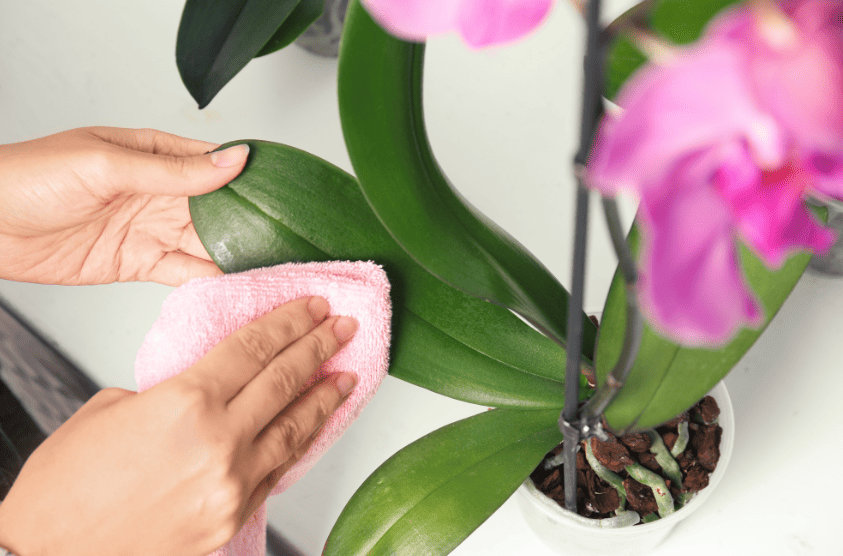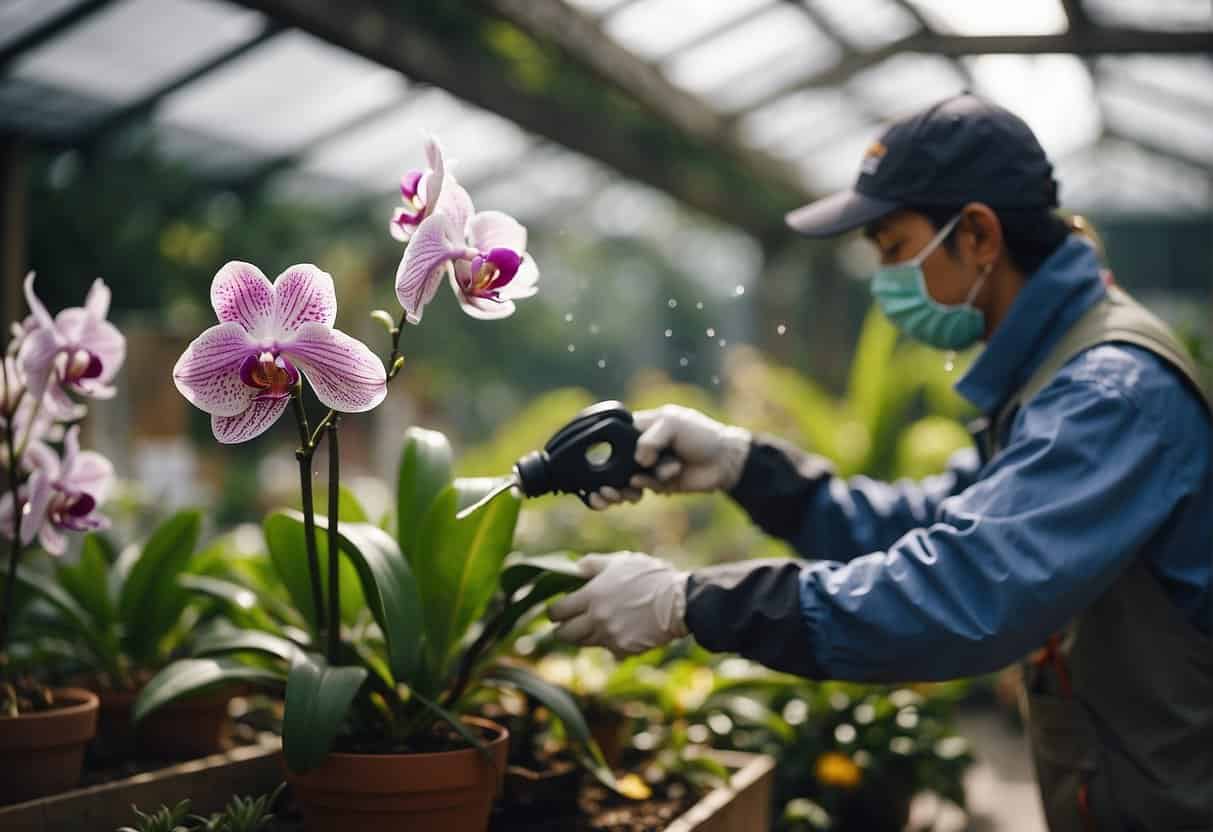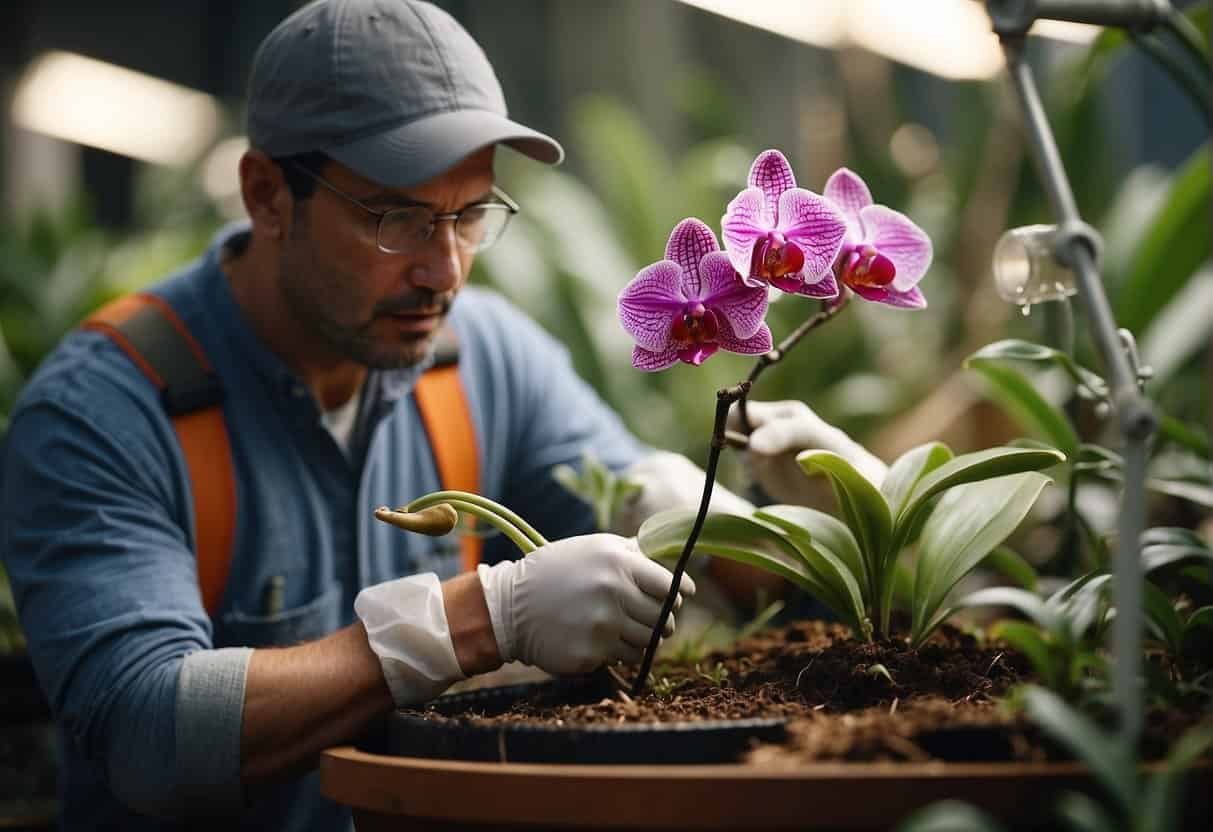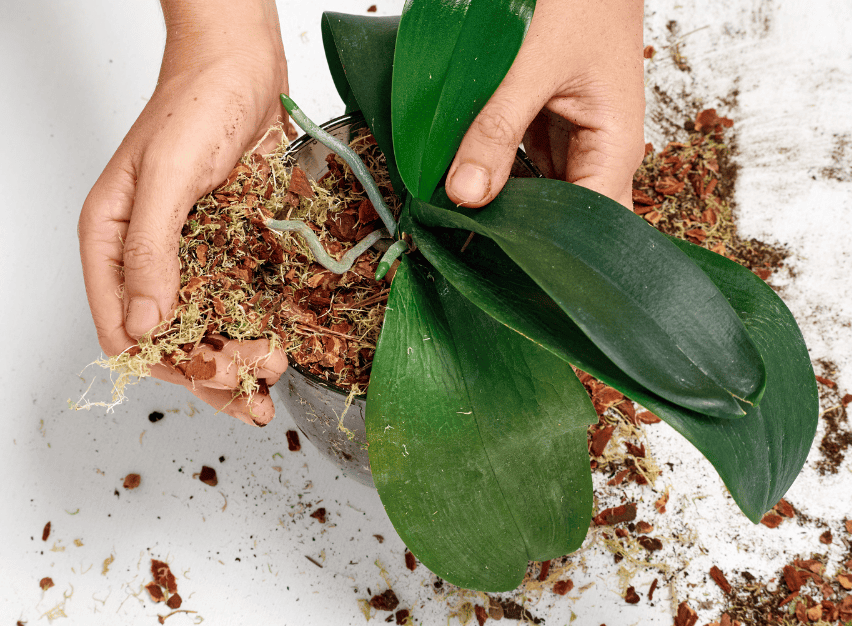Orchids are renowned for their exotic beauty and diverse species, each with unique care requirements. Despite their resilience, they can be vulnerable to a variety of pests and diseases that pose a threat to their health and longevity.
Effective prevention and prompt treatment of such issues are vital in maintaining the vitality of these delicate plants.
Common pests include scale insects, mites, and aphids, while diseases often manifest as fungal, bacterial, or viral infections.

Understanding the signs of infestation or disease is crucial for orchid owners.
Indications of trouble may range from visible pests on the foliage to unexplained spots, yellowing leaves, or stunted growth, which could denote a deeper health issue.
Early detection and identification of the problem underpin the success of any treatment and prevention strategy.
Maintaining a clean environment, regular inspection, and appropriate watering and feeding schedules can minimize the risk of pests and diseases.
When problems do arise, a range of treatments are available, from home remedies to commercial products, tailored to address specific threats without harming the plant or its environment.
Persistent cases may require intervention from orchid experts or plant pathologists to guide the recovery process and restore the health of affected specimens.
Understanding Orchid Pests and Diseases
Orchid cultivation can be a rewarding endeavor, but growers must be vigilant against a variety of pests and diseases that could compromise their plants’ health.
Common orchid diseases often include fungal infections, which present as a visible mold on the plant, or fungal diseases that can be detected by wilting and yellowing leaves. Understanding the signs and taking preventive steps are key to maintaining healthy orchids.
Orchid enthusiasts should be aware of:
- Fungal Diseases: These are common in orchids and include rood rot and leaf spots. Overwatering and poor air circulation often exacerbate these conditions.
- Viral Infections: Less common but potentially more severe, viral infections can spread quickly and are usually indicated by mottling and streaking on the leaves.
- Pests: Orchids can be affected by a range of pests like mites, scale insects, and aphids. These tiny creatures can cause significant damage by feeding on the sap and spreading diseases.
| Pests/Diseases | Common Signs |
|---|---|
| Fungal Infections | Mold, wilting, yellowing leaves |
| Viral Infections | Mottle, streaks on leaves |
| Pests | Visible insects, honeydew, leaf damage |
To prevent such issues, consistent inspection of orchids for the first signs of trouble can make a significant difference.
Adequate ventilation, proper watering routines, and hygienic practices are all essential safeguards.
Identifying and addressing orchid pests and diseases promptly ensures the longevity and beauty of these beloved plants.
Preventative Measures for Healthy Orchids
For orchid enthusiasts, ensuring their plants thrive involves adopting preventative measures.
Healthy orchids begin with proper care; it establishes a strong foundation against pests and diseases.
Air Circulation
- Proper ventilation is crucial.
- Fans or open windows can assist in airflow.
- This reduces the threat of fungal infections.
Regulating Humidity and Temperature
- Orchids prefer certain humidity levels—ideally between 40% to 70%.
- Investing in a hygrometer to monitor these conditions is wise.
- Temperature should be in line with the species-specific needs.
Isolation and Quarantine Practices
- New orchids should be isolated for 2-3 weeks to prevent the spread of possible diseases to other plants.
- During quarantine, scrutinize newcomers for signs of distress.
Sanitation
- Regularly clean tools and pots to eliminate potential pathogens.
- Diseased plant matter should be promptly and carefully disposed of.
By taking proactive steps in care and maintenance, orchid owners can often prevent issues before they become severe, promoting long-lasting orchid health.
Identifying Common Pests in Orchids

Orchid enthusiasts should monitor their plants for pests, which often present as tiny insects feeding on various parts of the plant.
Early identification and proper management are crucial to maintaining the health and beauty of orchids.
Aphids and Their Management
Aphids are small, sap-sucking insects that can infest orchids, often colonizing the undersides of leaves and tender new growth.
They excrete honeydew, which can lead to sooty mold and attract ants.
Controlling aphids involves spraying affected orchids with insecticidal soap or applying neem oil as a natural pesticide.
Carefully inspect plants for the presence of aphids, including their larvae and eggs.
Troubles with Thrips
Thrips are slender, tiny insects that cause damage by scraping at plant cells, leaving behind silver streaks or stippling on leaves and petals.
Effective treatment includes using systemically acting pesticides when larvae or adults are observed.
Physical removal by washing the plant and applying appropriate chemical treatments can mitigate thrip-related damage.
Combatting Scale Insects
Scale insects appear as small bumps on orchid leaves and stems, hiding beneath a protective covering while they feed on plant sap.
Managing scale may require physical removal with a soft brush or cloth, followed by horticultural or neem oil applications.
Regular inspections are necessary to catch infestations early, as scale insects can be stubborn once established.
Dealing with Mealybugs and Mites
Mealybugs and spider mites are also common orchid pests.
Mealybugs present as white, cotton-like masses, typically in leaf axils, while spider mites are nearly invisible, detected by webbing or leaf damage.
They may be managed using insecticidal soap or neem oil, ensuring thorough plant coverage, especially in crevices. Quarantine-infested plants to prevent spreading to others.
Recognizing Symptoms of Orchid Diseases

Orchid diseases manifest in various ways, often seen as changes in the plant’s normal appearance.
Early detection and accurate diagnosis are essential in managing these issues effectively.
Root Rot and Its Indicators
Root rot in orchids typically results from overwatering or poor drainage, leading to insufficient air around the roots.
Indicators of root rot include:
- Roots turn soft and brown, often accompanied by a foul odor.
- Yellowing of leaves and stunted growth due to the roots’ inability to absorb nutrients.
A healthy orchid root should be firm and either white or green.
If you notice soft, mushy roots with a brown coloration and foul smell, these are clear signs that the plant might be suffering from root rot and need attention.
Addressing Fungal Spot Diseases
Fungal infections often present as brown or black spots on the foliage and flowers.
These spots may be circled with a yellowish halo, escalating to a larger area of discoloration if the disease progresses.
Listed below are typical symptoms of fungal spot diseases:
- Brown spots or black spots on leaves, stems, or flowers.
- Yellow leaves surround the infected area.
- A presence of sticky debris on the plant, which can be fungal spores in disguise.
Inspect your orchids regularly for these symptoms, as prompt treatment with fungicides and improved air circulation can keep these issues in check.
Tackling Viral Infection Signs
Viral infections are some of the most challenging ailments to treat in orchids.
Symptoms can be subtle or develop slowly and typically manifest as patterned streaking or color-breaking on the flowers and buds, often mistaken for unique variegation.
Signs of viral infections may include:
- Mosaic or streaked patterns on the leaves, sometimes with ring spots.
- Discoloration and distortion in foliage.
- Wilting or wilted flowers, despite adequate care.
Orchids with suspected viral infections should be isolated to prevent spread to other plants, and any tools used should be disinfected.
There are no cures for viral infections; therefore, affected plants may need to be destroyed to protect others.
Effective Treatment Strategies

Effective treatment strategies are critical for restoring plant health when combatting orchid pests and diseases.
These strategies include applying chemical treatments and fungicides, implementing cultural controls, and the occasional necessity for repotting.
Chemical Treatments and Fungicides
Chemical applications are a direct approach to dealing with severe infestations and disease outbreaks in orchids. For pest control, options like horticultural oils and isopropyl alcohol can be employed to manage pests like mites and scale. Carefully applying these chemicals directly to the pests helps reduce their population effectively. It is crucial to follow the manufacturer’s instructions for proper dosage and application.
In the case of fungal infections, specific fungicides need to be utilized. A treatment regimen may involve multiple applications, spaced out according to product guidelines, to eradicate the pathogen fully. The use of chemicals should be considered a last resort and should always be preceded by less invasive measures.
Cultural Controls for Disease Management
Cultural controls are preventative measures that reduce the risk of pest and disease development. They form the backbone of disease management in orchid care.
Ensuring the right environmental conditions can inhibit the growth of pathogens. These conditions include adequate air circulation, optimal humidity, and suitable temperature.
Regular inspection of plants for early signs of damage is crucial, and infected parts should be removed promptly. Disinfecting tools with a bleach solution or alcohol after each use prevents the spread of diseases from plant to plant.
Repotting as a Rehabilitative Measure
Repotting an orchid can sometimes be necessary for disease control and as part of the treatment process, especially when dealing with root rots or when the growing medium has broken down.
When repotting, it is important to use sterile materials and containers to minimize the risk of further infection. Infected material should be carefully removed, and wounds on the plant can be treated with a fungicide or cinnamon powder to disinfect and aid in healing. After repotting, the orchid should be monitored closely to ensure recovery and prevent recurrence of the problem.
Environmental Management and Control

Managing the environment is critical to preventing and controlling orchid pests and diseases. Maintaining proper humidity, ensuring adequate airflow, and setting optimal temperature and lighting are essential practices for orchid health.
Optimizing Humidity and Air Flow
Orchids thrive in an environment with balanced humidity levels and good air circulation.
High humidity is beneficial for orchids, as it mimics their natural tropical habitat, but it should be coupled with proper air movement to prevent the onset of fungal and bacterial infections.
Maintaining humidity levels between 40% and 70% is recommended.
- Air Circulation: Use fans or open vents in a greenhouse to promote air movement, which helps to avoid poor air circulation and mitigates the risk of pests and diseases.
- Watering Practices: Water orchids early in the day to ensure that moisture on leaves can evaporate with the day’s warmth and air movement, reducing the potential for leaf-spotting diseases and pests that thrive in stagnant conditions.
Temperature and Lighting Conditions
Controlling temperature and light is essential for creating an ideal growth environment for orchids and limiting stress that can lead to diseases.
- Temperature: Stability in temperature is key; sudden fluctuations can stress orchids and make them more susceptible to diseases.
- Light: Provide bright but indirect light. Excessive direct sunlight can lead to burns, while insufficient light weakens the plant’s defenses.
Post-Infection Care and Recovery

After successfully treating orchid pests or diseases, the recovery phase begins. Isolation of the affected plant remains crucial to prevent any recurrence and spread of the infection. Keep the plant separated until it shows signs of significant improvement and healthy new growth.
Pruning is a vital step in removing any remaining infected plant tissue.
With sterilized tools, carefully cut away dead or diseased leaves, pseudobulbs, and roots. When pruning Vanda orchids, which have open and monopodial growth habits, focus on removing only the visibly affected areas so as not to hinder their vertical growth pattern.
Post-infection care includes:
- Monitoring: Regular check-ups to detect any signs of relapse.
- Environment: Ensuring optimum conditions—sufficient light, airflow, and humidity—supporting recovery.
- Watering: Adjust water needs, as overwatering can lead to root rot and other issues.
- Fertilization: A balanced feed promotes healthy new growth without overburdening the plant.
Hence, the key aspects of monitoring in the recovery phase are:
| Aspect | Action Item |
|---|---|
| Infected Material | Remove and dispose of responsibly. |
| Watering Schedules | Modify according to plant’s reduced needs. |
| Environmental Check | Maintain stable conditions suitable for orchid health. |
| Feeding | Use a dilute, balanced fertilizer to encourage growth. |
Refrain from repotting immediately, as this can stress the plant. Wait until the orchid has gained back some vigor. If bulbs or pseudobulbs are severely damaged, they may need to be discarded to encourage the development of healthy ones.
Recovery time varies and can take several months. Observing the emergence of vibrant, firm new growth is a sign that the orchid is recuperating and can eventually be returned to its place among other plants.
Advanced Topics in Orchid Care

When tackling advanced orchid care, it’s crucial to manage the delicate balance of the plant’s environment to prevent diseases like botrytis and infestations such as scale insects. Orchids demand careful attention to several factors that influence their health.
Moisture Management: Orchids are susceptible to overwatering.
So, it’s vital to ensure the potting medium is well-draining and allows roots to adequately absorb water without retaining excess moisture. This helps prevent fungal growth and the spread of pathogens.
- Fungal Prevention: Keep humidity levels in check to fend off mold and fungal issues. Botrytis, a type of fungus, thrives in high humidity and can be deterred with good air circulation. Remove affected leaves or flowers to prevent spores from spreading.
- Scale Control: Scale insects feed on orchid sap, weakening the plant. Regular inspections and the removal of these pests are critical. In cases of infestation, consider using horticultural oils or insecticidal soaps as treatment options.
Nutrient Balancing: Orchids require the right balance of nutrients for optimal growth.
Apply fertilizers carefully, according to the specific needs of your orchid species, to prevent nutrient burn.
Potting Medium Maintenance:
| Issue | Sign | Prevention/Treatment |
|---|---|---|
| Decomposed Medium | Soggy texture, bad odor | Replace with fresh media |
| Nutrient Deficiency | Pale leaves, stunted growth | Adjust fertilizer application |
| Pathogen Development | Discoloration, soft spots on roots | Sterilize pots and tools, use clean water |
Orchid Care Best Practices

Proper orchid care is imperative for preventing diseases and promoting healthy growth. Employing the right watering techniques, providing adequate nutrition, and enforcing isolation for new plants are foundational to maintaining orchid health.
Watering Technique for Preventing Diseases
Watering orchids correctly is crucial to their health and preventing potential diseases.
Orchids should be watered in the morning using lukewarm water, allowing the moisture to evaporate throughout the day. This minimizes moisture retention on leaves and roots overnight, which can lead to fungal growth.
One should ensure the potting medium is almost dry before re-watering to prevent root rot. Here are the steps:
- Use a pot with drainage holes.
- Water thoroughly until it runs out the bottom of the pot.
- Allow the potting medium to dry slightly between waterings.
Nutrition and Feeding for Resistance
Orchids require specific nutrients to thrive and resist diseases.
A balanced fertilizer can provide the necessary nutrients to promote healthy growth.
It’s recommended to fertilize orchids every other week during the growing season and reduce them to once a month during the winter.
A typical orchid fertilizer ratio is 20-20-20, but one must follow label directions for specific orchid types. Key points include:
- Use a fertilizer formulated for orchids.
- Dilute the fertilizer to half-strength to avoid nutrient burn.
- Apply when the potting medium is moist, not dry.
Implementing Effective Quarantine Protocols
To prevent the spread of pests and diseases, isolation and quarantine are essential when introducing new orchids into a collection.
Any new plants should be kept separate from existing plants for a minimum of two to four weeks to observe for signs of disease or pests. Effective quarantine includes:
- Sanitation of tools and hands after handling the quarantined orchid.
- Isolation of the new orchid in a separate room or space.
- Regular inspection for any signs of distress or infection.

